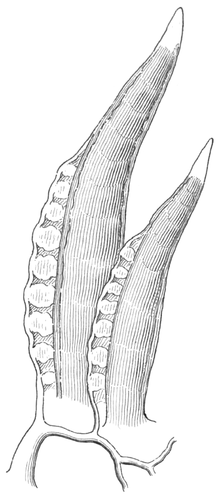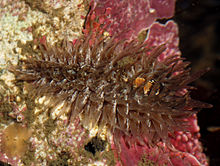- Cerata
-
 Drawing of cerata of Fiona pinnata. There are small efferent vessels in cerata with puckered membranous fringe on the inner sides. The vessels are leading to great median trunk.
Drawing of cerata of Fiona pinnata. There are small efferent vessels in cerata with puckered membranous fringe on the inner sides. The vessels are leading to great median trunk.
Cerata are anatomical structures found in nudibranch sea slugs, marine opisthobranch gastropod mollusks.
They are dorsal and lateral outgrowths on the upper surfaces of the body.
The singular is ceras, which comes from the Greek word "keratos", meaning "horn", a reference to its shape.
Function
Cerata greatly extend the surface area of nudibranchs and aid in respiration, the process of gas exchange for metabolic use.[1]
Cerata are also used, in some cases, for attack and defense. In many aeolid nudibranchs, the digestive system extends into the cerata. These nudibranchs eat stinging celled animals (Cnidarians) such as anemones, hydroids and sea fans or bluebottles. The stinging cells or nematocysts are passed unharmed through the digestive system to the tips of the cerata. Here the nematocysts mature and are then used by the nudibranch for its own defence.
In some nudibranchs, cerata are used as decoy tactics. Typically, these cerata are not armed with nematocysts, but when attacked, the nudibranch will autotomise or drop one or more of its cerata. The dropped cerata produce a sticky secretion and wriggle energetically for some time after being cast off, presumably causing a distraction and allowing the nudibranch to escape.[2]
References
- ^ BRUSCA, R.C. & BRUSCA, G.J. 2003 Invertebrates 2nd edition ISBN 0-87893-097-3
- ^ http://www.seaslugforum.net/factsheet.cfm?base=phylmagn accessed 12 November 2009
External links
Categories:- Mollusc anatomy
- Gastropods
Wikimedia Foundation. 2010.

